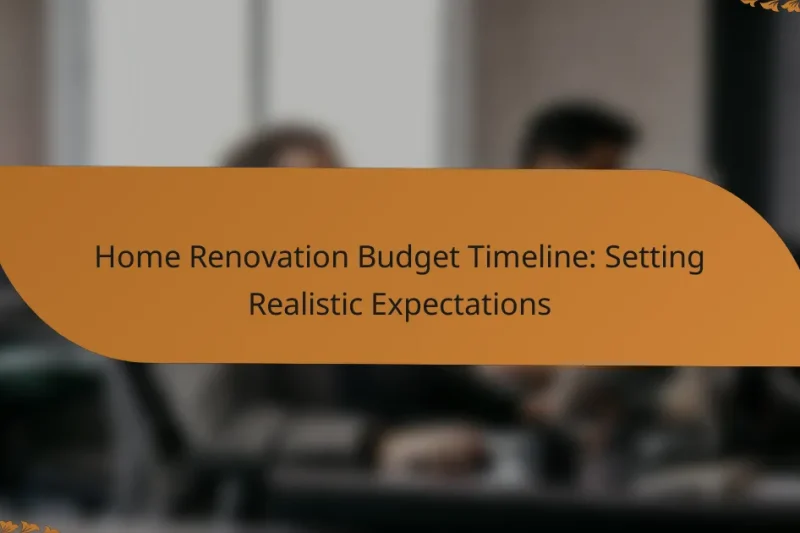Home renovation projects can often exceed initial budgets, leading to unexpected financial strain for homeowners. Understanding … Home Renovation Cost Overruns: Metrics, Causes and SolutionsRead more
Home Renovation Budgeting
Creating a home renovation budget is essential for successfully managing your project and finances. By outlining your goals and estimating costs, you can avoid common pitfalls such as underestimating expenses and neglecting unexpected costs. Prioritizing structural needs before aesthetic improvements will help ensure that your renovations are both practical and visually appealing.
Home Renovation Budget: First-Time Homeowner Strategies
Embarking on a home renovation journey as a first-time homeowner can be both exciting and daunting, … Home Renovation Budget: First-Time Homeowner StrategiesRead more
Eco-Friendly Renovation Budgeting: Costs, Savings and Benefits
Budgeting for eco-friendly renovations is essential for homeowners looking to enhance their living spaces while being … Eco-Friendly Renovation Budgeting: Costs, Savings and BenefitsRead more
Kitchen Renovation Budgeting: Essential Tips for Home Chefs
Renovating your kitchen can be an exciting yet daunting task, especially when it comes to budgeting. … Kitchen Renovation Budgeting: Essential Tips for Home ChefsRead more
Home Renovation Budgeting Tools: Features, Costs and Usability
Home renovation budgeting tools are essential for homeowners looking to estimate costs, track expenses, and manage … Home Renovation Budgeting Tools: Features, Costs and UsabilityRead more
Home Renovation Financing: Options, Benefits and Considerations
When planning a home renovation, understanding your financing options is crucial for a successful project. From … Home Renovation Financing: Options, Benefits and ConsiderationsRead more
Home Renovation Budget Timeline: Setting Realistic Expectations
Embarking on a home renovation requires careful planning, particularly when it comes to budgeting and timelines. … Home Renovation Budget Timeline: Setting Realistic ExpectationsRead more
How to create a home renovation budget?
Creating a home renovation budget involves outlining your goals, estimating costs, and accounting for various expenses. A well-structured budget helps you manage your finances effectively and ensures your project stays on track.
Identify renovation goals
Start by clearly defining your renovation goals. Determine what areas of your home need improvement and what specific changes you want to make, such as updating a kitchen, adding a bathroom, or enhancing curb appeal.
Prioritize your goals based on necessity and desired outcomes. This will help you allocate your budget more effectively and focus on the most impactful renovations first.
Estimate costs of materials
Research the costs of materials required for your renovation. This includes everything from flooring and cabinetry to paint and fixtures. Prices can vary significantly based on quality and brand, so consider both budget-friendly and premium options.
Gather quotes from local suppliers or use online tools to estimate material costs. A rough estimate can range from hundreds to thousands of dollars depending on the scope of your project.
Include labor expenses
Labor costs are a significant part of your renovation budget. Depending on the complexity of the work, hiring professionals can range from a few hundred to several thousand dollars. Always get multiple quotes from contractors to ensure competitive pricing.
If you plan to do some work yourself, factor in the value of your time and any tools you may need to purchase or rent. This can help you make informed decisions about which tasks to tackle yourself versus hiring out.
Factor in permits and fees
Many renovations require permits, which can add to your overall budget. Check with your local building department to understand what permits are necessary for your project and their associated costs, which can range from minimal fees to several hundred dollars.
In addition to permits, consider other fees such as inspection costs or homeowner association (HOA) approvals if applicable. These can impact your timeline and budget, so plan accordingly.
Set a contingency fund
Setting aside a contingency fund is crucial for any renovation budget. A common recommendation is to allocate 10-20% of your total budget for unexpected expenses that may arise during the project.
This fund can cover unforeseen issues such as structural problems, hidden damage, or changes in material prices. Having a contingency fund helps you avoid financial strain and keeps your project moving forward smoothly.
What are common budgeting mistakes in home renovation?
Common budgeting mistakes in home renovation include underestimating costs, neglecting unexpected expenses, and ignoring the importance of quality. These errors can lead to financial strain and project delays, making it crucial to plan effectively.
Underestimating costs
Many homeowners fail to accurately estimate the total costs of their renovation projects. This often occurs when initial quotes do not include all necessary materials, labor, and permits. A good rule of thumb is to add an additional 10-20% to your budget to cover these potential oversights.
For example, if a kitchen remodel is estimated at $20,000, consider budgeting between $22,000 and $24,000 to accommodate any unforeseen expenses. Always obtain multiple quotes and clarify what is included in each estimate.
Neglecting to account for unexpected expenses
Unexpected expenses are a common occurrence in home renovations, often arising from hidden issues like plumbing or electrical problems. Failing to prepare for these surprises can derail your budget significantly.
To mitigate this risk, set aside a contingency fund of around 15-20% of your total budget. This fund can help cover any surprises that arise during the renovation process, ensuring you stay on track financially.
Ignoring the importance of quality
Choosing lower-quality materials or cutting corners to save money can lead to higher costs in the long run. Poor-quality work may require repairs or replacements sooner than expected, negating any initial savings.
Investing in quality materials and skilled labor can enhance the durability and aesthetic appeal of your renovation. Consider prioritizing essential areas, such as kitchens and bathrooms, where quality can significantly impact your home’s value and functionality.
How to prioritize renovation projects?
To prioritize renovation projects effectively, focus on addressing structural needs first, followed by aesthetic improvements and energy efficiency upgrades. This approach ensures that essential repairs are made before enhancing the visual appeal or sustainability of your home.
Assess structural needs first
Start by identifying any structural issues that could compromise the safety and integrity of your home. This includes checking for problems with the foundation, roof, plumbing, and electrical systems. Addressing these needs typically requires a larger portion of your budget, so prioritize them accordingly.
Consider hiring a professional inspector to evaluate the condition of your home. They can provide insights into urgent repairs and help you understand the costs involved, which often range from a few hundred to several thousand dollars depending on the severity of the issues.
Evaluate aesthetic improvements
Once structural needs are addressed, focus on aesthetic upgrades that enhance the overall look and feel of your home. This can include painting, flooring, and landscaping. These projects can vary significantly in cost, from affordable DIY options to more expensive professional renovations.
When planning aesthetic improvements, consider which areas of your home will provide the most visual impact. For example, updating the kitchen or bathroom often yields a higher return on investment compared to other rooms, making them a smart choice for homeowners looking to increase property value.
Consider energy efficiency upgrades
Energy efficiency upgrades can reduce utility bills and improve comfort in your home. Common upgrades include installing energy-efficient windows, adding insulation, and upgrading heating and cooling systems. These improvements can often qualify for rebates or tax incentives, making them more affordable.
When budgeting for energy efficiency projects, consider the long-term savings they can provide. While upfront costs may vary widely, many homeowners find that energy-efficient upgrades pay for themselves over time through reduced energy expenses. Aim for improvements that have a payback period of five years or less for the best return on investment.
What financing options are available for home renovations?
Home renovations can be financed through various options, each with its own advantages and considerations. Common methods include home equity loans, personal loans, and government grants or programs, which can help homeowners manage costs effectively.
Home equity loans
Home equity loans allow homeowners to borrow against the equity they have built in their property. Typically, these loans offer lower interest rates compared to personal loans, as they are secured by the home itself. Borrowers can usually access a percentage of their home’s appraised value, often ranging from 70% to 90% of the equity.
When considering a home equity loan, it’s essential to evaluate your ability to repay, as failure to do so could result in losing your home. Additionally, closing costs and fees can apply, so reviewing the total cost of borrowing is crucial.
Personal loans
Personal loans are unsecured loans that can be used for home renovations, offering flexibility in how funds are utilized. These loans typically have higher interest rates compared to home equity loans since they do not require collateral. Loan amounts can vary widely, often ranging from a few thousand to tens of thousands of dollars.
When opting for a personal loan, it’s important to shop around for the best rates and terms. Consider your credit score, as it significantly impacts the interest rate you may receive. Be cautious of any hidden fees that could increase the overall cost of the loan.
Government grants and programs
Government grants and programs can provide financial assistance for home renovations, particularly for low-income households or specific projects like energy efficiency upgrades. These grants do not require repayment, making them an attractive option for eligible homeowners.
To access these funds, homeowners should research local and federal programs, as availability and eligibility criteria can vary. Common programs include the U.S. Department of Housing and Urban Development (HUD) grants and state-specific initiatives. Always verify the requirements and application processes to ensure you maximize available resources.
How to track renovation expenses effectively?
To track renovation expenses effectively, establish a clear system that allows for real-time updates and reviews. This ensures you stay within budget and can make informed decisions throughout the renovation process.
Use budgeting apps like Mint
Budgeting apps such as Mint provide a user-friendly platform to monitor renovation expenses. These apps allow you to categorize spending, set budget limits, and receive alerts when nearing those limits.
Consider linking your bank accounts and credit cards to the app for automatic tracking. This can save time and help you avoid missing any expenses, ensuring a comprehensive overview of your renovation costs.
Maintain a detailed spreadsheet
A detailed spreadsheet can be a powerful tool for tracking renovation expenses. Create columns for categories such as materials, labor, permits, and unexpected costs to keep everything organized.
Regularly update the spreadsheet with receipts and invoices. This practice not only helps in tracking spending but also aids in identifying areas where you might be overspending.
Regularly review and adjust budget
Regular budget reviews are essential for effective expense tracking during renovations. Set aside time weekly or bi-weekly to assess your spending against your budget and make necessary adjustments.
If you find certain areas exceeding your budget, consider reallocating funds from less critical categories. This proactive approach helps maintain financial control and ensures the renovation stays on track.






